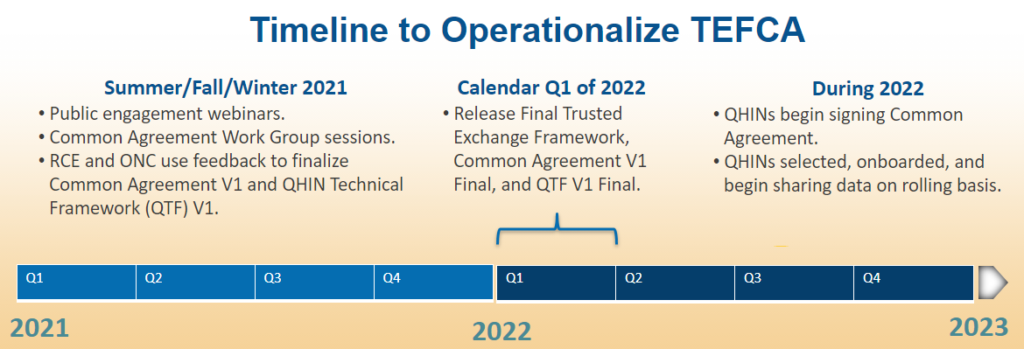
 By Micky Tripathi, National Coordinator for Health Information Technology, ONC and
By Micky Tripathi, National Coordinator for Health Information Technology, ONC and
Mariann Yeager, CEO, The Sequoia Project (the TEFCA Recognized Coordinating Entity)
Twitter: @ONC_HealthIT
Twitter: @mickytripathi1
Twitter: @MariannYeager
We are pleased to announce the timeline for the Trusted Exchange Framework and Common Agreement (TEFCA). The 21st Century Cures Act, signed by President Obama in 2016, calls on ONC to “develop or support a trusted exchange framework, including a common agreement among health information networks nationally.”
In August 2019, ONC awarded a cooperative agreement to The Sequoia Project to serve as the Recognized Coordinating Entity (RCE) to administer a new nationwide network based on the Common Agreement. Since then, ONC and the RCE have worked together to gather industry-wide stakeholder input to draft and refine the approach to enabling nationwide health information exchange across different health information networks. The timeline released today—for completion of the Trusted Exchange Framework, the Common Agreement Version 1 and the Qualified Health Information Network (QHIN) Technical Framework (QTF) Version 1—establishes our goal to have this new network open for participation in the first quarter (Q1) of calendar year 2022.
Enhancing the value of network exchange
The interoperability of medical records has steadily progressed in recent years following a monumental national effort to get high adoption of electronic health records among hospitals and ambulatory practices. Nationwide networks currently facilitate the secure exchange of millions of clinical documents on a daily basis and state/regional health information exchanges (HIEs) provide localized interoperability services in many parts of the country.
However, some significant gaps remain. For example, we need networks to be seamlessly connected with each other. While the nationwide networks have made considerable progress in this area, cross-network exchange is still not frictionless, and most state/regional HIEs serve only their local markets and many are not connected to any other networks at all. This presents barriers to better care, higher costs to the health care system, and a diminished user experience for patients and providers alike. Data from the 2018-2019 American Hospital Association Annual Survey of Information Technology Supplement (as summarized in ONC’s Data Brief #54) found that nearly half of hospitals participate in more than one network and thus have to manage the burden of multiple network connections, legal contracts, network fees, and user workflows.
We also need networks to open the aperture of exchange to support the entire health care system, including the most important participant in health care—the patient. Today, the nationwide networks largely support exchange among health care providers for treatment purposes to the exclusion of other critical use cases such as public health, individual access, care management, population health, payment support, research, supply chain awareness, and emergency response. The COVID-19 pandemic made abundantly clear that our clinical and public health systems live in different interoperability universes. For example, it is not easy for public health authorities and individual clinicians to bring information together on seemingly simple questions such as: Which of my patients are not yet vaccinated?
The Internet has taught us that networks are more valuable together than apart. The overall goal for TEFCA is to establish a floor of universal interoperability across the country. Networks of many shapes, sizes, and capabilities exist today and we anticipate they will continue to provide interoperability services over and above the basic foundation established by the Common Agreement. Throughout our work, one of our longstanding principles has been to build on the successes of networks already present in the market—not to stifle or replace them. The consistent and dependable services enabled by the Common Agreement will do this by lowering the cost of basic information sharing and, thus, will free up resources for more value-added services, creating a competitive and even playing field for existing and newly emerging networks, and filling in the gaps of cross-network exchange. The Common Agreement will establish the infrastructure model and the governing approach for users in different networks to securely share basic clinical information with each other—all under commonly agreed-to expectations and rules and regardless of which network they happen to be in.
TEFCA timeline and process
The ONC and the RCE are announcing a timeline and process to achieve a successful launch of the TEFCA framework within a year. Specifically, our goal is to open up participation in Q1 of calendar year 2022 and there is much to do between now and then.

Our work on TEFCA has a number of key components. Qualified Health Information Networks (QHINs) are networks that agree to the common terms and conditions of exchange with each other (as specified in the Common Agreement) and to the functional and technical requirements for exchange (as specified in the QHIN Technical Framework or QTF).
The RCE has already received considerable market input over the last two years. There will be more opportunities for additional stakeholder input to the Common Agreement and QTF throughout the remainder of 2021, including reconvening of the Common Agreement Work Group comprised of prospective QHINs and their participants.
We welcome input on all aspects of the TEFCA model including such topics as required and optional exchange purposes, privacy and security policies, required and optional exchange patterns, and incorporation of Health Level Seven (HL7®) International® Fast Healthcare Interoperability Resources (FHIR®) standard in the QTF roadmap. This collaborative process will culminate with publication of the Common Agreement V1 Final and QTF V1 Final in Q1 of calendar year 2022, at which point health information networks will be able to apply to become QHINs and, after approval, begin on-boarding on a rolling basis.
As technology and business arrangements and user requirements and use cases evolve and emerge over time, so too will the Common Agreement and QTF, which will be living documents that will be updated periodically as needed and through the RCE’s participatory governance process to address areas for future optimization.
The Sequoia Project plays a critical role in bringing depth and breadth of market expertise, experience, and trust to the RCE’s role of governing health information network exchange through the Common Agreement. ONC is pleased to announce that it has awarded a new round of funding of $942,000 to The Sequoia Project under the RCE cooperative agreement to support RCE activities from August 2021 to August 2022.
Get Involved
We encourage stakeholders to participate in the RCE’s future information sessions. You can keep apprised of these meetings by adding your name to the RCE’s contact list at RCE.SequoiaProject.org.
For detailed background on TEFCA, please visit: HealthIT.gov/TEFCA.
This article was originally published on the Health IT Buzz and is syndicated here with permission.
